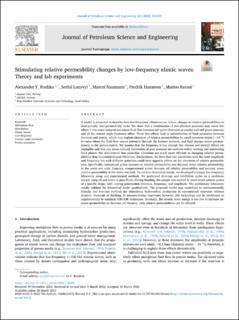| dc.contributor.author | Rozhko, Alexander | |
| dc.contributor.author | Lozovyi, Serhii | |
| dc.contributor.author | Naumann, Marcel | |
| dc.contributor.author | Hansteen, Fredrik | |
| dc.contributor.author | Ravasi, Matteo | |
| dc.date.accessioned | 2023-01-09T09:44:46Z | |
| dc.date.available | 2023-01-09T09:44:46Z | |
| dc.date.created | 2022-08-24T14:17:31Z | |
| dc.date.issued | 2022 | |
| dc.identifier.citation | Journal of Petroleum Science and Engineering. 2022, 215 (A), 1-22. | en_US |
| dc.identifier.issn | 0920-4105 | |
| dc.identifier.uri | https://hdl.handle.net/11250/3041839 | |
| dc.description.abstract | A model is presented to describe how low-frequency vibrations can induce changes to relative permeabilities in dual-porosity dual-permeability rocks. We show that a combination of two physical processes may cause this effect: 1) the wave-induced two-phase fluid flow between soft pores (fractures or cracks) and stiff pores (matrix); and 2) the contact angle hysteresis effect. These two effects lead to redistribution of fluid saturation between fractures and matrix, which may explain alteration of relative permeabilities by small transient strains (∼10−6) in rocks where the fluid flow occurs primarily through the fracture network, and fluid storage occurs predominantly in the porous matrix. We assume that the frequency is low enough that viscous and inertial effects are negligible and that any stress-induced increments of pore pressure are uniform within wetting and nonwetting fluid phases. We demonstrate that pulse-like vibrations are much more efficient in changing relative permeabilities than sinusoidal-shaped vibrations. Furthermore, we show that two waveforms with the same amplitude and frequency but with different polarities could have opposite effects on the alteration of relative permeabilities. Specifically, extensional pulses increase oil relative permeability and decrease water relative permeability in the water-wet rock. Contrary, compressional pulses decrease oil relative permeability and increase water relative permeability in the water-wet rock. To validate theoretical results, we developed a unique low-frequency laboratory setup and experimental methods. We performed drainage and imbibition cycles on a sandstone sample using oil and water as pore fluids. During flooding, the sample was excited by small-strain seismic pulses of a specific shape, with varying polarization direction, frequency, and amplitude. The preliminary laboratory results validate the theoretical model qualitatively. The proposed model may contribute to environmentally friendly and low-cost methods for stimulating hydrocarbon production in conventional reservoirs without invasive chemicals or fracking. In unconventional reservoirs, however, this technology can be envisioned as supplementary to standard EOR/IOR techniques. Normally, the seismic wave energy is too low to increase absolute permeability or decrease oil viscosity; only relative permeabilities can be affected. | en_US |
| dc.language.iso | eng | en_US |
| dc.publisher | Elsevier | en_US |
| dc.rights | Attribution-NonCommercial-NoDerivatives 4.0 Internasjonal | * |
| dc.rights.uri | http://creativecommons.org/licenses/by-nc-nd/4.0/deed.no | * |
| dc.subject | Partial saturation | en_US |
| dc.subject | Contact angle hysteresis | en_US |
| dc.subject | Low-frequency | en_US |
| dc.subject | Elastic waves | en_US |
| dc.subject | Stimulation | en_US |
| dc.subject | Multiphase flow | en_US |
| dc.title | Stimulating relative permeability changes by low-frequency elastic waves: Theory and lab experiments | en_US |
| dc.title.alternative | Stimulating relative permeability changes by low-frequency elastic waves: Theory and lab experiments | en_US |
| dc.type | Peer reviewed | en_US |
| dc.type | Journal article | en_US |
| dc.description.version | publishedVersion | en_US |
| dc.rights.holder | © 2022 The Authors. Published by Elsevier B.V. | en_US |
| dc.source.pagenumber | 1-22 | en_US |
| dc.source.volume | 215 | en_US |
| dc.source.journal | Journal of Petroleum Science and Engineering | en_US |
| dc.source.issue | A | en_US |
| dc.identifier.doi | 10.1016/j.petrol.2022.110393 | |
| dc.identifier.cristin | 2045701 | |
| dc.source.articlenumber | 110393 | en_US |
| cristin.ispublished | true | |
| cristin.fulltext | original | |
| cristin.qualitycode | 2 | |

